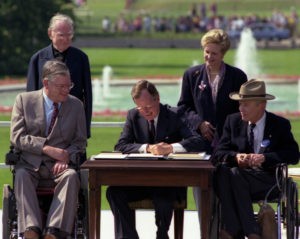When you think about marginalized communities, who do you envision? Most Americans do not think to include a key group — people with disabilities.
This week marks a major milestone for this marginalized community, with the 30th anniversary of the Americans with Disabilities Act.

President George H.W. Bush signs the Americans with Disabilities Act on the South Lawn of the White House. Sharing the dais with the president are Rev. Harold Wilkie of Clairmont, Calif.; Sandra Parrino, National Council on Disability; Evan Kemp, Equal Opportunity Commission; and Justin Dart, Presidential Commission on Employment of People with Disabilities.
(George Bush Presidential Library and Museum)
The ADA prohibits discrimination against people with disabilities in employment, education, transportation and any place that is open to the general public. At the bill-signing ceremony for the legislation, President George H.W. Bush hailed the ADA as “the end to the unjustified segregation and exclusion of persons with disabilities from the mainstream of American life.”
And, indeed, the ADA has been monumental in giving more opportunities to Americans with disabilities in all facets of public life. Still, steep hurdles remain in the fight for equality.
Significant employment gap
The ADA defined a disability as any physical or mental impairment that substantially limits one or more life activities. By that standard, an estimated one in four Americans lives with a disability. The legislation gave legal protection to anyone with a disability, on par with race, color, sex and other protected classes. In plain terms, the ADA made it illegal for employers to discriminate or deny employment to otherwise qualified individuals on the basis of their disability.
The law also required employers to provide “reasonable accommodations” to otherwise-qualified individuals with disabilities who are job applicants or employees, as long as those accommodations don’t create “undue hardship.” These provisions have gone a long way in ensuring that individuals with disabilities are afforded the same employment opportunities as their non-disabled peers.
Still, fewer than 20% of adults with disabilities were employed in 2019, compared with 66% of those without a disability. The fact that people with disabilities tend to be older than those without explains some of this discrepancy. However, the employment gap is prevalent across all age groups. In addition, 32% of employees with a disability worked only part time, compared with 17% of non-disabled employees.
Pervasive stereotypes
“There are a vast amount of stereotypes that keep companies from hiring,” said April Allen, program director at My Possibilities, a nonprofit organization in Plano, Texas, that offers vocational education and job placement services for adults with intellectual and developmental disabilities. Employers “think that the accommodations will be too expensive — but they’re really an average of about $500.”
Additionally, Allen said, many employers have preconceived notions that disabled people can’t learn or won’t be able to do the job well or at all. But the reality is far different.
“It has been proved that for the adults we place in jobs the turnover is so low,” she said. “They are so enthusiastic about having a job. They’re loyal and they stay there. For many, it’s their first paycheck.”
This is one area where the letter of the ADA law can only do so much. Stereotypes about people with disabilities are still pervasive in many parts of society.
The task that remains is “about breaking down those biases,” Allen said.
Reasonable accommodations

Jennifer Evans
Another need is increasing education about the reasonable accommodation provision of the ADA, said Jennifer Evans, who lives in New Mexico and has cerebral palsy. She struggled in the workplace because she didn’t know how to ask her employer for accommodations that would have helped her.
“I was taught that you live in the world the way it is, and you don’t ask the world to bend to you,” she said. “So when it came to a professional work environment where you can ask for things, I didn’t even think to ask. The only thing in my head was, ‘You have to work harder.’ And maybe if I had asked, things would be different.”
The disparity in employment rates between disabled and non-disabled Americans has significant downstream effects, and this is but one example of the systemic challenges people with disabilities still encounter.
Educational disparities and economic outcomes
The challenges begin even before individuals with disabilities enter the labor force. In 2018, the percentage of individuals with disabilities who earned a bachelor’s degree was less than half that of individuals without disabilities. After entering the labor force, the disparities are even starker:
- Individuals with disabilities earn 37% less than people without disabilities who have similar educational backgrounds, according to the American Institutes for Research.
- Among full-time workers, those with disabilities earned an average of $40,454 in 2018, compared with $46,250 for those without disabilities.
- Among individuals with post-secondary degrees, people with disabilities make $20,000 less than their non-disabled peers.
- A disproportionate number of people with disabilities are impoverished. In 2018, an estimated 26% of individuals with disabilities were living in poverty — nearly double the percentage of the non-disabled population.
Health disparities
Individuals with disabilities often have more frequent, more significant and more complex health issues than non-disabled individuals. According to the Centers for Disease Control and Prevention, adults with disabilities are three times more likely to develop chronic diseases such as heart disease, stroke, diabetes or cancer than adults without disabilities and are less likely to receive needed preventive screenings such as mammograms.
Yet, according to a 2019 study, less than half — about 46% — of individuals with disabilities had private health insurance, compared with nearly 76% of those without disabilities. This, again, reflects the stark employment disparities that still exist.
Exclusion from some aspects of public life
“If you’re physically not able to get in the building or feel welcome, how many times are you going to keep going back?”
The ADA required all public places to be accessible to those with disabilities, and, indeed, many now include accessibility aides such as ramps, automatic door openers, wider restroom doors and Braille signs. But exceptions exist, notably in older or historic buildings and those in which making such modifications would create “undue hardship” on the building owner.
And, notably, the ADA exempted churches from making their buildings accessible.
“Many old church buildings are inaccessible, and the ADA doesn’t require churches to conform,” said Ben Rhodes, director of academic engagement for the Christian Institute on Disability at Joni and Friends, an organization dedicated to ministry outreach to individuals affected by disability.
“Think of the message that sends not just to the disabled but to the elderly,” Rhodes said. “If you’re physically not able to get in the building or feel welcome, how many times are you going to keep going back?
A journey, not a destination
Three decades after the ADA’s passage, individuals with disabilities and their advocates continue to fight for equality.
“We have a long way to go,” Allen said, “but the ADA has paved the way and there’s been so much advocacy, whether it be in employment or education. There’s been great strides to give people with disabilities a voice.”
Helen Jerman is a professional writer and editor in Dallas who is paralyzed from the knee down due to spina bifida and is a wheelchair user as a result. She earned a bachelor’s degree in journalism from Baylor University and now works in corporate communications.
This story was made possible by gifts to the Mark Wingfield Fund for Interpretive Journalism.


